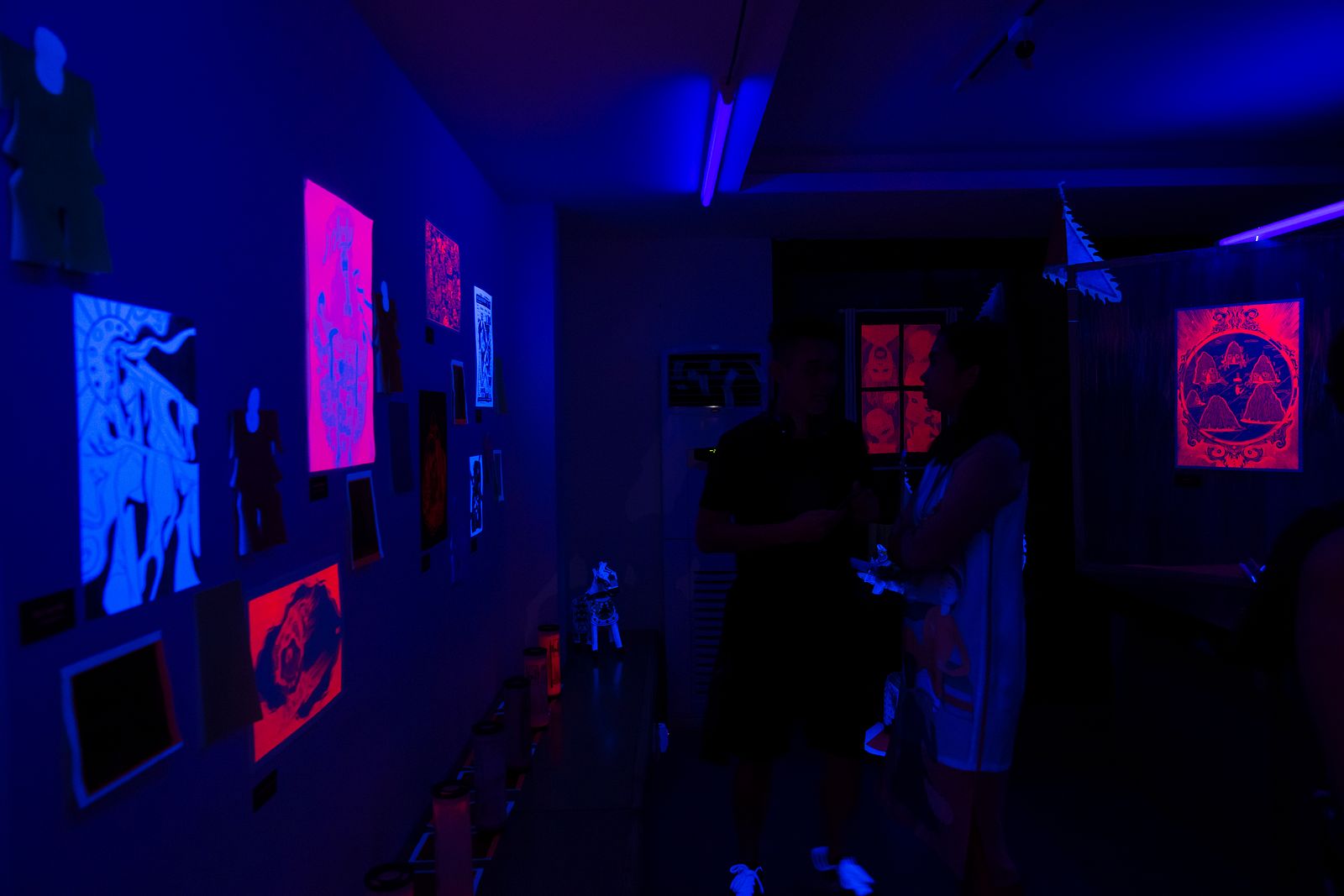Of all the forms of music one hears on the streets of modern-day Saigon, the sounds of the marching bands accompanying funeral processions stand out as absolutely unique.
The instrumentation is highly unusual for Vietnamese traditional music: an array of trumpets and trombones, with driving percussion usually centered on a bass drum and a snare drum. But even more strikingly, the mood of the music is entirely different from other traditional forms. Instead of the mournful, formal melodies one hears in other funeral music around the country, this music is almost celebratory, with lively brass improvisations over upbeat, syncopated rhythms.
The first comparison one might reach for is that of the New Orleans jazz funeral tradition, where community marching bands in military-style outfits combine martial, religious and African musical influences in one of the world’s most compelling funerary rituals. Saigon art collective The Propeller Group explored the similarities between the two in their acclaimed contribution to the 2014 New Orleans Biennale, 'The Living Need Light, the Dead Need Music', a video installation featuring Vietnamese musicians playing both traditional melodies and the classic New Orleans jazz tune 'It Ain’t My Fault'.
Video via YouTube user IndieLisboa.
Certainly, there are noticeable parallels. However, Dr. Matt Sakakeeny, Associate Professor of Music at the University of Tulane in New Orleans, tells Saigoneer: “there is no direct connection between musical processions in Vietnam and in New Orleans at funerals. Many cultures celebrate in times of mourning, and these are two fascinating cases, but there is not necessarily anything more than an imagined link between the two traditions.”
Video via YouTube user Salvatore Sebergandio.
Dr. Nguyen Thi My Liem, vice director of the Ho Chi Minh Conservatory of Music and a leading specialist on southern Vietnamese ceremonial music, concurs, describing the funeral bands heard in the south of the country as “music [that] doesn’t follow any rules, and they improvise. It’s not real jazz.” She adds that some of the additional performers one sees in modern funeral bands, such as dancers or cross-dress dancers, are “a recent addition and not a traditional one.”
Much of the energetic music we hear in funeral processions in southern Vietnam, then, falls both outside the scope of jazz and of officially recognized traditional Vietnamese folk forms. So what are its origins?
In this article, we will use archival sources to attempt to decipher the story of how this music became part of southern Vietnamese culture. It is a story that spans four continents, and touches upon an almost forgotten history of Saigon’s jazz era. To begin, we must ask: how did brass band music originally arrive in Vietnam?
Some of the earliest mentions of brass bands in Vietnam are found in the records of French Catholic missionary organizations from the 1910s, where one can read of the existing popularity of local marching bands among Christian converts in Que Son. We can also see brass bands listed among the techniques employed by missionaries in rural Vietnam to “enhance this ceremony in the eyes of heathens [sic]”. During the imperial era, Christian proselytizing was frequently accompanied by the recruitment and training of brass band musicians. For example, in 1918, France’s Pontifical Missionary Society for the Propagation of the Faith was simultaneously deploying such bands in regions which today are parts of Vietnam, India and Zimbabwe.
Dr. Nguyen of the Conservatory of Music observes that today’s brass band funerals in Saigon predominately take place among Catholic communities. Regarding the uniforms of these bands, she further notes that “each band has its own uniform, typically black and white - resembling the French military uniforms.”

Photo by Lee Starnes.
This is the key to the other path by which brass music was globalized during the imperial era: militarism. Beginning in the 1880s, the French colonial administration began recruiting regiments of Vietnamese riflemen to help expand French-controlled territory. These regiments, the Tirailleurs indochinois, were disproportionately drawn from Christian converts. The regiments also had marching bands which commonly performed the French national anthem, 'La Marseillaise', and the World War I song 'La Madelon'.
The archives of L’Echo Annamite, the newspaper of the French colonial administration in southern Vietnam, tell the story of the rapid expansion of this music in the 1920s. The marching band Fanfare Saigonnaise appears to have been the hottest musical draw in mid-1920s Saigon, providing musical accompaniment to sporting events ranging from an international boxing tournament to the opening of a new football stadium. Meanwhile, the larger-than-life figure of Jacques Le Van Duc was turning his interests towards the promotion of the genre.

A 1925 advertisement for a boxing tournament featuring Musique de la Fanfare Saigonnaise. Photo via Gallica.
Le Van Duc, a Vietnamese aristocrat from My Tho, was a unique character in his era: a Marseille-educated, world-travelled cosmopolitan, he found literary success in France with his travel writings on Europe and the Middle East, but preferred to live on his Mekong Delta estate. Enthralled with brass band music, Le Van Duc organized a major competition for bands in Saigon in 1927.
Le Van Duc, a Francophile through and through, held a vision of the future of Vietnamese music which was shared by the French colonial administration: the imperial power’s “civilizing mission” in Vietnam was to instill French cultural values, including those of music, in the local population. However, Vietnamese brass music would very soon take several radically different turns.
In 1927, the same year as Le Van Duc's French music competition in Saigon, the military marching band of the Tirailleurs Annamites played specifically southern Vietnamese music at the inauguration of a temple: It was becoming clear that the Vietnamese, even those serving in the French military, were openly asserting their own folk traditions using brass band instruments.

Photo by Lee Starnes.
Standard French martial music was far from abandoned, though. Indeed, in 1930, it was notably adopted by one movement which famously had no interest in accepting anything else from France: the insurgents of the Xo Viet Nghe-Tinh (XVNT), Vietnam’s first large-scale local uprising against the French occupation. The rise of the XVNT took place to the sounds of marching bands playing 'La Marseillaise' – but accompanied by new lyrics, titled 'Song Calling the Proletariat to Revolution'.
All of this goes some way to explain the adoption of Western brass instrumentation in Vietnamese musical culture. It does not, however, explain the evident jazz influences one hears in the music of southern Vietnamese funeral bands. For this, we must look to the wider history of jazz in early 20th-century Southeast Asia.
Vietnam’s Jazz Age
Much of the early emergence of jazz in Southeast Asia can be attributed to the influence of French colonialism. France itself began to embrace jazz during World War I, when the most popular public concerts for French troops and civilians were those of the US Army’s 369th Infantry “Harlem Hellfighters” Band, led by early jazz bandleader James Reese Europe. The French passion for jazz fully exploded in the mid-1920s, with the arrival in Paris of a number of African-American jazz legends, most notably soprano saxophonist Sidney Bechet and dancer Josephine Baker. For post-war France, jazz was the music of the future.
All of this had an effect on the French colonies: by the 1930s jazz was performed in cities all over East and Southeast Asia, including Saigon, Hanoi, Phnom Penh and Shanghai. And in most, or perhaps all, of these cities, the most popular live jazz bands of the era were composed of Filipinos, rather than French or local musicians.
The Philippines was a US colony from 1898 to 1935. For much of this period and beyond, Manila was seen by elites across Asia as the continent’s center of musical modernity: a culture in direct contact with popular new African-American musical forms without European intercession. Manila bands became Asia’s most respected and sought-after musicians, recruited to play in “theaters, clubs, and entertainment venues from Guam to Tokyo and Hong Kong, to Bangkok and Singapore, and all the way to the Middle East. In the 1930s, Filipino jazz bands were the most sought-after in Shanghai,” according to the University of Amsterdam’s meLê yamomo. “Outside the elite opera houses of the French colonial Hanoi and Saigon, Filipinos worked as orchestra and dancehall musicians and teachers to the Vietnamese elite,” yamomo writes.
However, it would be a mistake to think that Vietnamese jazz in this period was solely the preserve of the elites. In Taking to the Waves, Erich DeWald’s history of the role of radio in 1930s Vietnamese society, the opposite is shown to be true. DeWald’s description of 1930s Vietnamese music culture will seem oddly familiar to anyone who has walked the streets of Saigon in 2016.

Photo by Lee Starnes.
“Those who could purchase a [radio] set did so and exhibited it prominently…in order to demonstrate their own social and cultural arrival. Such ostentatious displays permitted a wider engagement with radio technology among Vietnamese than European usage allowed. By placing radios prominently near windows and turning the volume up for all to hear, in contrast to the European tendency to conceal the radio within the house and to keep the noise to a minimum, radios owned by Vietnamese were social technologies used—or experienced—by more people than their owners and their intimates alone. Broadcasts reached more people, creating a wider listening public and more engagement and re-engagement with the medium and its messages. This pattern was strongest and widest in the south.”
In other words, street-level dissemination of music in 1930s Saigon occurred in exactly the same way as it occurs today – except, instead of sound systems blasting out EDM and karaoke, it was radios blasting jazz. DeWald further notes that the private French companies behind the launch of Vietnam’s radio networks made it clear that all broadcast content must be entirely non-political. As a result, one style of music in particular was favored. “Jazz was a particularly popular programming option, whose consumption was conspicuously modern,” DeWald writes.
The mainstream popularity of jazz, especially in Saigon, continued into the 1960s. Australian educationalist Bern Brent described the music scene he encountered in the city in 1959 in the following terms: “In the Western world rock was beginning to supplant jazz, but in South Vietnam the bands in hotels, restaurants and night spots still favored the melodies of the [world] war years. Songs like 'Jealousy' and 'Smoke Gets in Your Eyes' alternated with French evergreens like 'J’attendrai'. Dinner was not compulsory. One could sip a drink and listen to the music.”
Southern Vietnamese funeral music in a global context
While the historical currents discussed above are key in understanding the uniqueness of funeral music in southern Vietnam, it is also possible to situate this music within the much wider global tradition of music which evolved in the colonial era from a fusion of Western instrumentation and indigenous musical traditions. Jazz itself fits into this category. Originating in New Orleans in the late 19th century, it was a hybrid musical form whose key influences included West African musical traditions retained by survivors of the transatlantic slave trade, elements of Christian religious music and European instrumentation.


Photos by Lee Starnes.
The repurposing of imperial musical instruments to give new voice to the cultural traditions of colonial subjects was a global phenomenon, and its effects can be seen all over the world today, including in traditional funeral rites. We can see it in New Orleans jazz funerals, and in southern Vietnamese marching band funerals. We can also see it in funeral traditions all over the post-colonial world, from Jamaica in the Caribbean to Ghana in West Africa.
The uplifting sound of southern Vietnamese brass band funeral music is a rich part of Vietnam’s cultural tapestry, but it is also more than that: it is part of the global story of religious and musical syncretism in funeral traditions which emerged worldwide during the colonial era.














